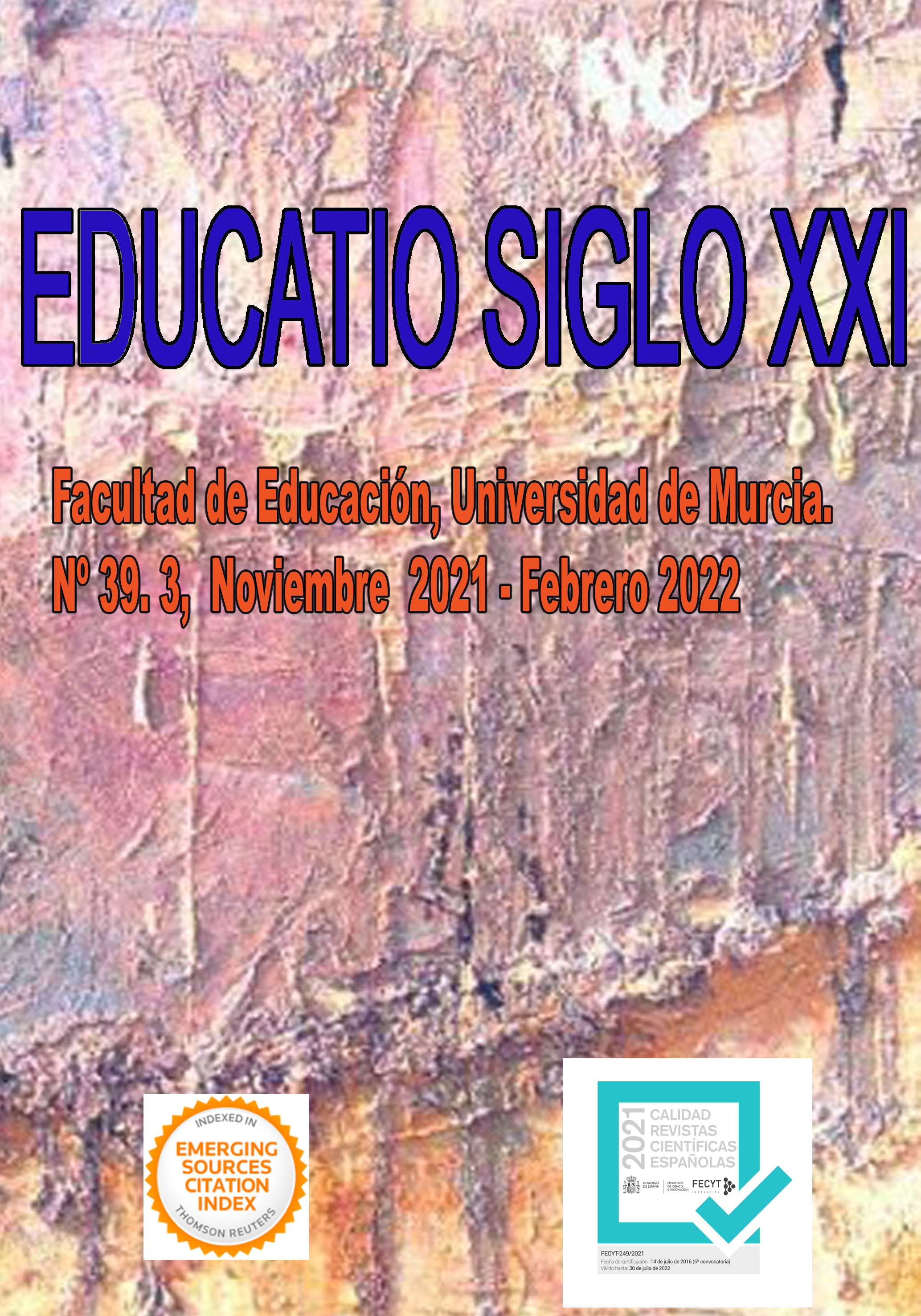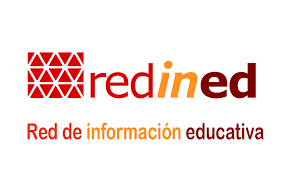Ludic and creative grammar. An experience to make grammatical contents in Primary Education more accessible
Abstract
Teaching language and literature should be a ludic and sensorial experience for students, especially when it comes to developing curricular content targeting students’ own reflection about their language and grammar. Data were obtained through the completion of creative and playful activities about language, developed first with 18 students of Education Degree in Soria (University of Valladolid) and, later, with 274 students from six Primary schools where university students developed their curricular practices. The experience consisted of the design and conduction, under school tutors’ supervision, of creative games which targeted three linguistic levels: letters, words and texts. More specifically, the objectives included: to awake learners’ curiosity and critical thinking; to promote reflection on the linguistic code for improving oral and written expression; and to facilitate the assimilation of several grammatical contents freely, autonomously and cooperatively. Since these activities were presented as games, they were applied with the same performance levels at university and at primary school settings. Mistakes were considered opportunities for creativity. The results obtained confirm the value of teaching grammar in a playful and creative way. Most of the Primary students improved their results in terms of effort, linguistic correction and reading aloud. University students highlighted the importance of including recreational resources in teaching and learning processes as this had a positive effect on primary school learners’ affective attitude. The results obtained reinforce the importance of suggestion-pedagogy as a method in language teaching. This work exposed an experience with 18 university students from Education Degree in Soria (University of Valladolid) who have been involved as part of their own university training and later they have applied this experience to 274 students from six schools of the city, during its curricular practices. This experience consisted, under the supervision of their tutors in Schools, in several activities applied as creative games with three linguistic levels: letters, words and texts, with the aim of awakening curiosity and critical sense, promoting reflection on the linguistic code and improve oral and written expression, while assimilating various grammatical contents freely, autonomously and cooperatively. When activities are presented as games, they could be applied with equal performance in various educational stages. In its realization, error was seen as a creative opportunity (Rodari, 2008). The results confirm the value of this methodology, while highlighting the help it can offer to teachers for the treatment of academic content that, with more traditional approaches, presents more assimilation difficulties among students, due to its limited ability to motivate him and arouse his interest, but necessary to develop linguistic and communicative competence.Downloads
-
Abstract2702
-
PDF (Español (España))1601
References
Abad, J. (2009). Iniciativas de Educación Artística a través del Arte Contemporáneo para la Escuela Infantil (3-6 años) (Tesis doctoral, Universidad Complutense). Recuperado de https://eprints.ucm.es/9161/
Bernal Ruiz, J. A. y Brito Soto, L. F. (2006). 1,2,3 Por todos mis compañeros: algunos juegos de ayer y hoy en México y España. Sevilla: Wanceulen Editorial Deportiva S.L.
Bizquerra Alzina, R. y Pérez Escoda, N. (2007). Las competencias emocionales. Educación XXI, 10, 61-82. https://doi.org/10.5944/educxx1.1.10.297
Caro Valverde, M. T. (2006). Los clásicos redivivos en el aula. Modelo didáctico interdisciplinar en educación literaria. (Tesis doctoral, Universidad de Murcia). Recuperado de http://digitum.um.es/xmlui/handle/10201/117
Chomsky, (1972). Studies on semantic in generative grammar. La Haya: Mouton Publishers.
De la Torre, S. (2006). Comprender y evaluar la creatividad. Málaga: Aljibe.
De la Torre, S. (2009) La Universidad que queremos. Estrategias creativas en el aula universitaria. Revista Digital Universitaria, (10), 12, 1-17. Recuperado de http://www.revista.unam.mx/vol.10/num12/art89/int89.htm
Elisondo, R. M. (2018). Creatividad y educación: llegar con una buena idea. Creatividad y Sociedad, (27) 145-166.
Elisondo, R.; Danolo, D. y Rinaudo, M. (2011). Docentes inesperados y creatividad. Experiencias en contextos de educación superior. DOCREA, 1, 103-114.
Fernández Fernández, I., Eizagirre Sagardia, A., Arandia Loroño, M., Ruiz de Gauna Bahillo, P. y Ezeiza Ramos, A. (2012). Creatividad e innovación: claves para intervenir en contextos de aprendizaje. Revista Iberoamericana sobre Calidad, Eficacia y Cambio en Educación, 10, 2, 24-40.
Freire, Juan (2009). Monográfico "Cultura digital y prácticas creativas en educación". RUSC Universities and Knowledge Society Journal, 6, (1). http://dx.doi.org/10.7238/rusc.v6i1.23
Fueguel, C. y Montolíu, M. R. (2005). El malestar docente, propuestas creativas para reducir el estrés del profesorado. Barcelona: Octaedro.
García Carcedo, P. (2011). Escritura creativa y competencia literaria. Lenguaje y Textos, 33, 49-59.
García Hoz, V. (1977). Estudios experimentales sobre el Vocabulario. Madrid: C.SIC.
García Velázquez, A. y Llull Peñalba, J. (2009). El juego infantil y su metodología. Madrid: Editex.
Guastalegnanne, H. (2009). Juegos para trabajar gramática y vocabulario en la clase ELE. Suplementos marco ELE, 9, 1-34
Guerrero Ruiz, P. (2008): Metodología de investigación en educación literaria (El modelo ekfrástico). Murcia: DM.
Hidalgo Cabrera, M. (2007). Expresión de la palabra. Lima: San Marcos.
Huizinga, J. (1997). Homo Ludens. (Imaz, E., trad.). Madrid: Altaya.
Instituto Cervantes (ed. trad.) (2002). Marco Común Europeo de Referencia de las Lenguas. Recuperado de http://cvc.cervantes.es/ensenanza/biblioteca_ele/marco/cvc_mer.pdf
Labrador Piquer, M. J. y Morote Magán, P. (2008). El juego en la enseñanza de ELE. Glosas Didácticas, 17, 71-84.
Lantigua, J. (2007). El deterioro de los juegos tradicionales. Lecturas: EF y Deportes, 106. Recuperado de http://www.efdeportes.com
Lojo-Seoane, C., Facal, D., Juncos-Rabadán, O. y Pereiro, A. X. (2014). El nivel de vocabulario como indicador de reserva cognitiva en la evaluación del deterioro cognitivo ligero. Anales de psicología, 30, 3, 1115-1121. https://doi.org/10.6018/analesps.30.3.158481
Lotman, I. (2000). La semiosfera. Semiótica de las artes y de la cultura (Navarro, D., trad.). Madrid: Cátedra.
Lozanov, G. (1978). Suggestology and outlines of suggestopedy. Nueva York: Gordon and Breach.
Martí, L. (2010). Los cien lenguajes de la infancia. Cuadernos de Pedagogía, 401, 17-21.
Martínez Vidal, A. y Díaz Pereira, P. (Coord.) (2008). Creatividad y deporte. Consideraciones teóricas e investigaciones breves. Sevilla: Wanceulen Editorial Deportiva.
Milla Lozano, F. (1999): Actividades creativas para la lecto-escritura (Educación Primaria y ESO). Barcelona: Oikos-Tau.
Morote Peñalver, E. (2014). La escritura creativa en las aulas del grado de primaria. Una investigación-acción. Revista electrónica de Estudios filológicos, 26, 1-25.
Murillo Rojas, M. (2009). Diversidad de vocabulario en los preescolares. Aportes para valorar su competencia léxica. Filología y Lingüística XXXV, 1, 123-138. https://doi.org/10.15517/rfl.v35i1.1271
Nevado Fuentes, C. (2008). El componente lúdico en las clases de ELE. MarcoELE, 7, 1-14. Recuperado de: http://marcoele.com/descargas/7/nevado_juego.pdf
Nussbaum, M. (2012). Sin fines de lucro. Por qué la democracia necesita de las humanidades (Rodil, M. V., trad.). Buenos Aires/Madrid: Katz.
Pérez Escoda, N., Filella Guiu, G., Soldevila, A. y Fondevila, A. (2013). Evaluación de un programa de educación emocional para profesorado de primaria. Educación XX1, 16 (1), 233-254. https://doi.org/10.5944/educxx1.16.1.725
Piacente, T., Fernicola, A. y Piatti, V. (2010). Nivel de vocabulario en alumnos universitarios de psicología. Análisis preliminar. II Congreso Internacional de Investigación y Práctica Profesional en Psicología. Facultad de Psicología -Universidad de Buenos Aires, Buenos Aires.
Piaget J. y Inhelder, B. (2007). La psicología del niño. Madrid: Morata.
Pisonero del Amo, I. (2004). “La enseñanza de español a niños y niñas” En Sánchez Lobato, J. y Santos Gargallo, I. (Dirs): Vademécum para la formación de profesores. Enseñar español como segunda lengua (L2)/lengua extranjera (LE) (pp. 1279-1302).
Rodari, G. (2008). Gramática de la fantasía: introducción al arte de contar historias. (3ª ed). Buenos aires: Colihue.
Rodríguez Moreno, M. L. (2006). De la Evaluación a la Formación de Competencias Genéricas: Aproximación a un Modelo. Revista Brasileira de Orientação Profissional, 7 (2), 33-48.
Romero, J. (2010). Creatividad distribuida y otros apoyos para la educación creadora. Pulso, 33, 87-107
Rouquette, M. L. (2002). Representaciones, historia y discurso. Revista internacional de Psicología Social, 1 (1), 73-78.
Santamaría, P., Arribas, D., Pereña, J. y Seisdedos, N. (2014). EFAI. Evaluación Factorial de las Aptitudes Intelectuales. Madrid: Tea
Spearman, C. (1923). The nature of “intelligence” and the principles of cognition. London: McMillan.
Suárez Ramírez, S. (2015). Los titulares en los cibermedios deportivos. Principales figuras retóricas y su aplicación didáctica (Tesis doctoral, Universidad de Extremadura). Recuperado de http://dehesa.unex.es/handle/10662/3089
Terman, L. (1916). The measurement of intelligence. Boston: Houghton Mifflin Company.
Vilera, A. (2004). Juegos electrónicos: reto a los procesos educativos y pedagógicos. Acción Pedagógica, 13 (2), 212-227.
Copyright (c) 2021 Servicio de Publicaciones de la Universidad de Murcia

This work is licensed under a Creative Commons Attribution-NonCommercial-NoDerivatives 4.0 International License.
Original work publishes in this journal is subject to the following terms:
1. Murcia University Press (the publishing house) holds the copyright of the publishes work, and favours and allows their reutilization under the use license stated in point 2.
© Servicio de Publicaciones, Universidad de Murcia, 2015
2. Work is published in the electronic edition under a license (Creative Commons Reconocimiento-NoComercial-SinObraDerivada 4.0 España (legal text). They can be copied, used, disseminated, transmitted and publicly presented, as long as: i) authorship and original publication source is acknowledged (journal, publishing house and URL of the work); ii) are not used for commercial purposes; iii) the existence and specifications of this use license is stated.
3. Conditions for self-archive. Authors are allowed and encouraged to disseminate electronically the pre-pint (before review) and/or post-print (accepted for publication) versions of their work before their publication since that favours earlier circulation and dissemination resulting in an increased chance for the authors to be cited and for the work to reach a bigger share of the academic community. Colour: RoMEO: green.







